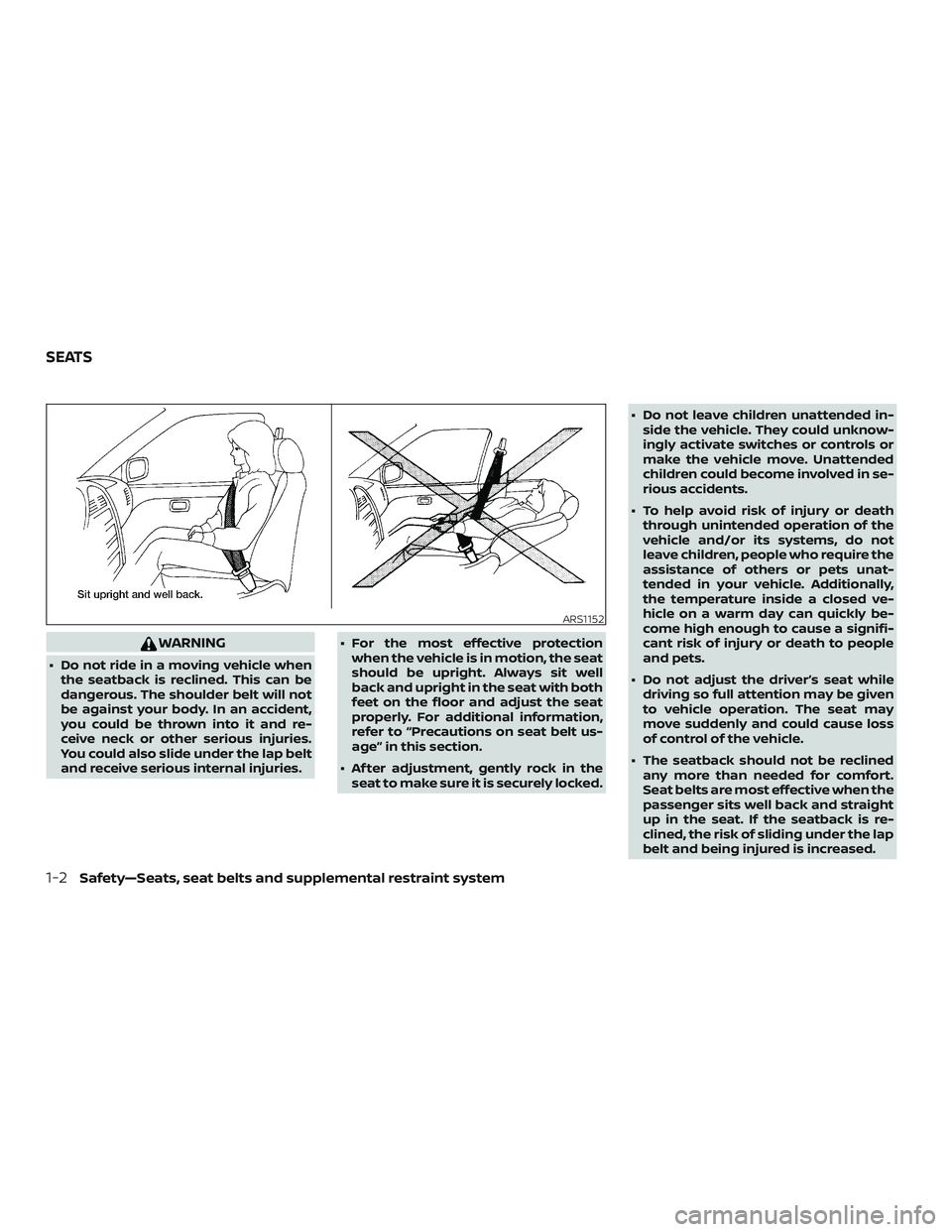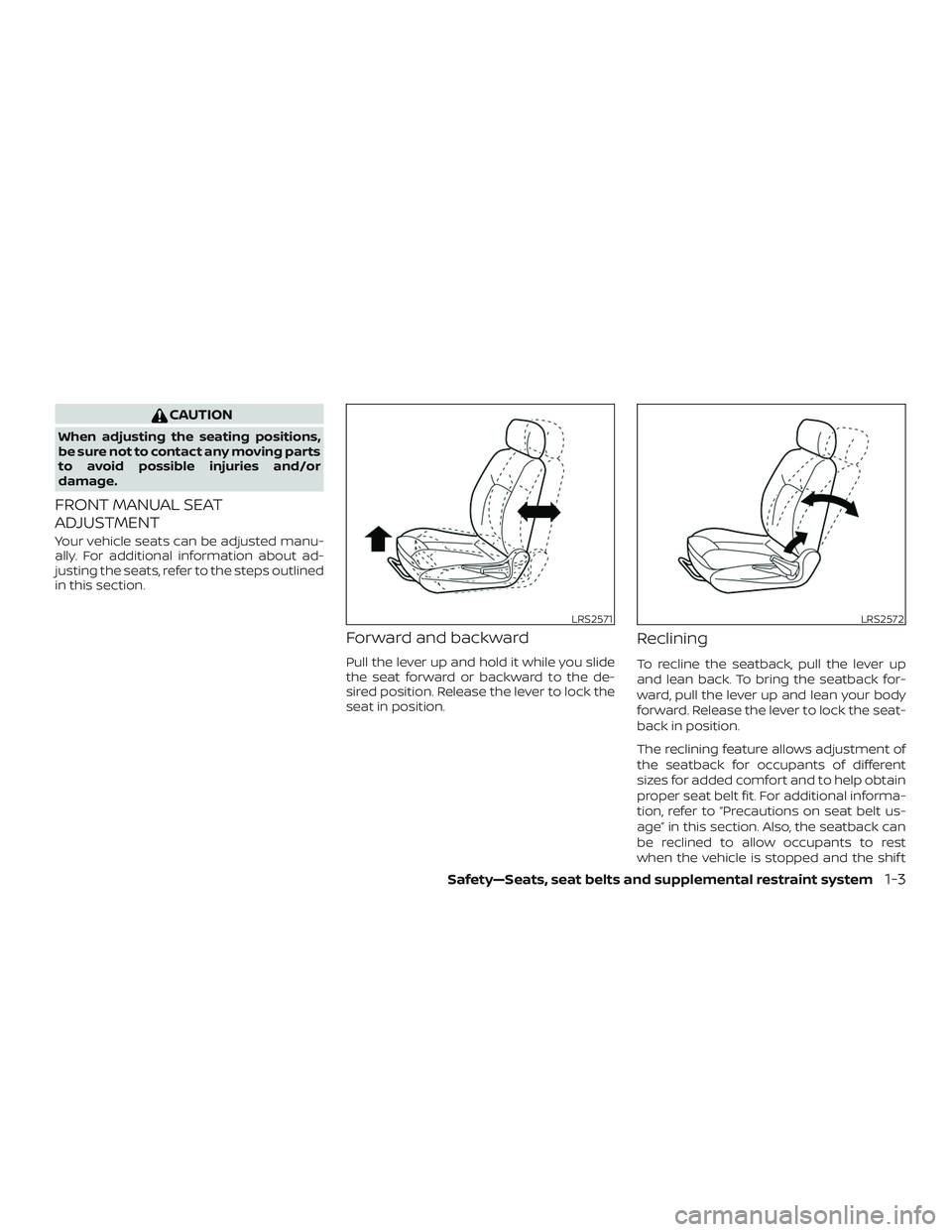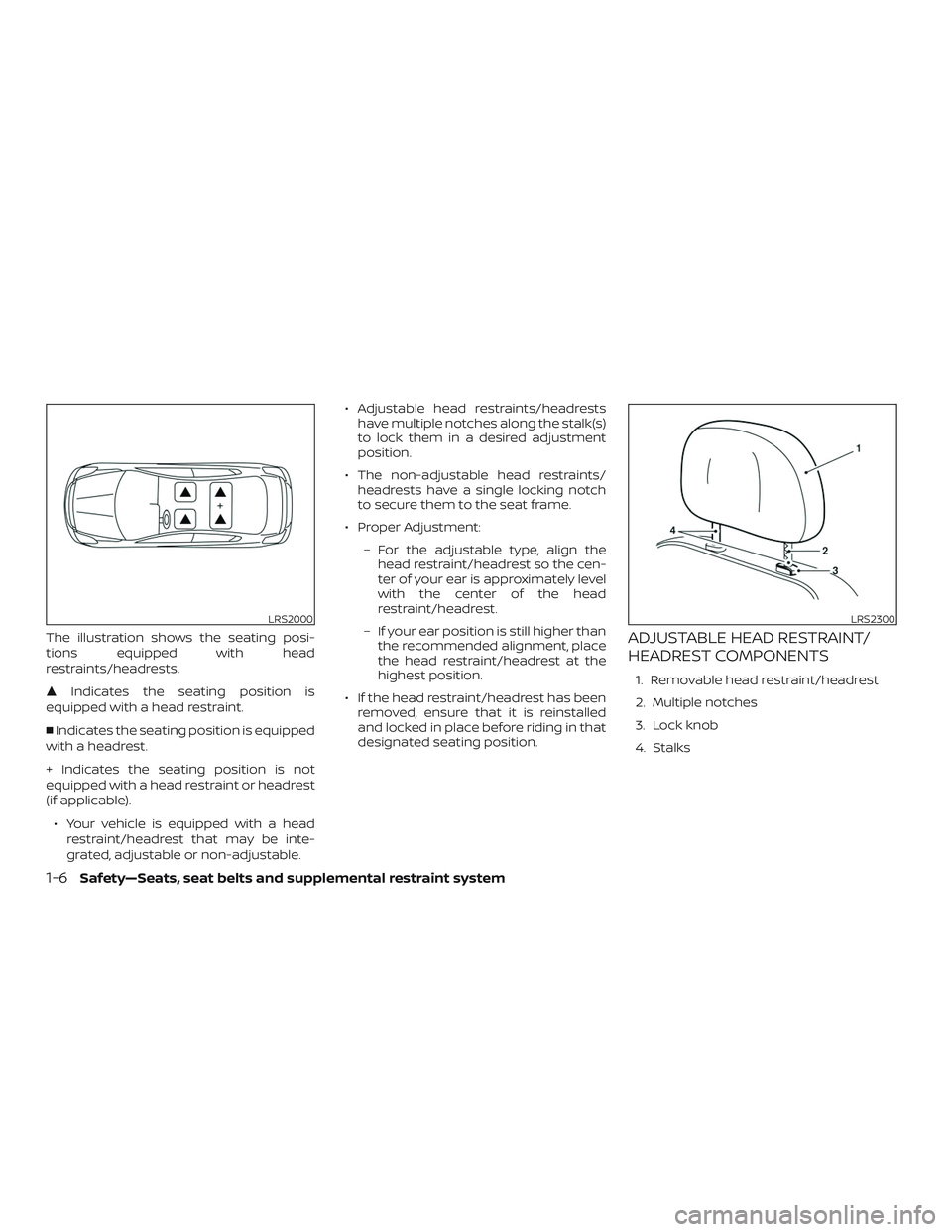Page 8 of 354
Table of
ContentsIllustrated table of contents
Safety—Seats, seat belts and supplemental restraint system
Instruments and controls
Pre-driving checks and adjustments
Display screen, heater, air conditioner, audio and phone systems
Starting and driving
In case of emergency
Appearance and care
Do-it-yourself
Maintenance and schedules
Technical and consumer information
Index
0
1
2
3
4
5
6
7
8
9
10
11
Page 11 of 354
1. Supplemental air bag modules
(P. 1-42)
2. Roof-mounted curtain side-impact
and rollover supplemental air bag
(P. 1-42)
3. Front seat-mounted side-impact
supplemental air bag (P. 1-42)
4. Front seat belt with pretensioner(s)
and shoulder height adjuster
(P. 1-10, 1-42)
5. Head restraints/headrests (P. 1-5)
6. Rear seat belts (P. 1-10)
7. LATCH (Lower Anchors and Tethers
for CHildren) system (P. 1-20)
8. Seats (P. 1-2)
9. Occupant classification sensor
(weight sensor) (P. 1-42)
Refer to the page number indicated in
parentheses for operating details.
LII2315
AIR BAGS, SEAT BELTS AND CHILD
RESTRAINTS
0-2Illustrated table of contents
Page 20 of 354

1 Safety—Seats, seat belts and
supplemental restraint system
Seats............................................ 1-2
Front manual seat adjustment................1-3
Folding rear seat (if so equipped)............. 1-4
Armrest (if so equipped for driver’s side
only).......................................... 1-5
Head restraints/headrests...................... 1-5
Adjustable head restraint/headrest
components................................. 1-6
Non-adjustable head restraint/
headrest components.........................1-7
Remove.......................................1-7
Install......................................... 1-8
Adjust........................................ 1-8
Seatbelts .......................................1-10
Precautions on seat belt usage...............1-10
Seat belt warning light (if so equipped).......1-13
Pregnant women.............................1-13
Injured persons...............................1-13
Three-point type seat belt with
retractor .....................................1-13
Seat belt extenders...........................1-17Seat belt maintenance.......................1-17
Child safety......................................1-18
Infants.......................................1-19
Small children................................1-19
Larger children...............................1-19
Child restraints.................................1-20
Precautions on child restraints..............1-20
LATCH (Lower Anchors and Tethers for
CHildren) system............................1-23
Rear-facing child restraint installation
using LATCH.................................1-25
Rear-facing child restraint installation
using the seat belts.........................1-27
Forward-facing child restraint
installation using LATCH.....................1-30
Forward-facing child restraint
installation using the seat belts..............1-33
Booster seats...............................1-38
Supplemental Restraint System (SRS)...........1-42
Precautions on SRS..........................1-42
Supplemental air bag warning labels........1-59
Supplemental air bag warning light..........1-60
Page 21 of 354

WARNING
∙ Do not ride in a moving vehicle when
the seatback is reclined. This can be
dangerous. The shoulder belt will not
be against your body. In an accident,
you could be thrown into it and re-
ceive neck or other serious injuries.
You could also slide under the lap belt
and receive serious internal injuries.∙ For the most effective protection
when the vehicle is in motion, the seat
should be upright. Always sit well
back and upright in the seat with both
feet on the floor and adjust the seat
properly. For additional information,
refer to “Precautions on seat belt us-
age” in this section.
∙ Af ter adjustment, gently rock in the
seat to make sure it is securely locked.∙ Do not leave children unattended in-
side the vehicle. They could unknow-
ingly activate switches or controls or
make the vehicle move. Unattended
children could become involved in se-
rious accidents.
∙ To help avoid risk of injury or death
through unintended operation of the
vehicle and/or its systems, do not
leave children, people who require the
assistance of others or pets unat-
tended in your vehicle. Additionally,
the temperature inside a closed ve-
hicle on a warm day can quickly be-
come high enough to cause a signifi-
cant risk of injury or death to people
and pets.
∙ Do not adjust the driver’s seat while
driving so full attention may be given
to vehicle operation. The seat may
move suddenly and could cause loss
of control of the vehicle.
∙ The seatback should not be reclined
any more than needed for comfort.
Seat belts are most effective when the
passenger sits well back and straight
up in the seat. If the seatback is re-
clined, the risk of sliding under the lap
belt and being injured is increased.
ARS1152
SEATS
1-2Safety—Seats, seat belts and supplemental restraint system
Page 22 of 354

CAUTION
When adjusting the seating positions,
be sure not to contact any moving parts
to avoid possible injuries and/or
damage.
FRONT MANUAL SEAT
ADJUSTMENT
Your vehicle seats can be adjusted manu-
ally. For additional information about ad-
justing the seats, refer to the steps outlined
in this section.
Forward and backward
Pull the lever up and hold it while you slide
the seat forward or backward to the de-
sired position. Release the lever to lock the
seat in position.
Reclining
To recline the seatback, pull the lever up
and lean back. To bring the seatback for-
ward, pull the lever up and lean your body
forward. Release the lever to lock the seat-
back in position.
The reclining feature allows adjustment of
the seatback for occupants of different
sizes for added comfort and to help obtain
proper seat belt fit. For additional informa-
tion, refer to “Precautions on seat belt us-
age” in this section. Also, the seatback can
be reclined to allow occupants to rest
when the vehicle is stopped and the shif t
LRS2571LRS2572
Safety—Seats, seat belts and supplemental restraint system1-3
Page 23 of 354
lever is in P (Park) or N (Neutral) position
with the parking brake fully applied.
Seat lif ter (if so equipped for
driver’s seat)
Pull up or push down the adjusting lever to
adjust the seat height until the desired po-
sition is achieved.
FOLDING REAR SEAT (if so
equipped)
�1Pull the knob�Ato fold each seatback
down.
WARNING
∙ Never allow anyone to ride in the
cargo area or on the rear seat when it
is in the fold-down position. Use of
these areas by passengers without
proper restraints could result in seri-
ous injury or death in an accident or
sudden stop.
LRS2573LRS2833
1-4Safety—Seats, seat belts and supplemental restraint system
Page 24 of 354

∙ Properly secure all cargo with ropes or
straps to help prevent it from sliding
or shif ting. Do not place cargo higher
than the seatbacks. In a sudden stop
or collision, unsecured cargo could
cause personal injury.
∙ When returning the seatbacks to the
upright position, be certain they are
completely secured in the latched po-
sition. If they are not completely se-
cured, passengers may be injured in
an accident or sudden stop.
∙ Closely supervise children when they
are around the cars to prevent them
from playing and becoming locked in
the trunk where they could be seri-
ously injured. Keep the car locked,
with the rear seatback and trunk lid
securely latched when not in use, and
prevent children’s access to car keys.
ARMREST (if so equipped for
driver’s side only)
To use the armrest, pull it down to the rest-
ing position.
�AStowed position
�BResting position
WARNING
Head restraints/headrests supplement
the other vehicle safety systems. They
may provide additional protection
against injury in certain rear end colli-
sions. Adjustable head
restraints/headrests must be adjusted
properly, as specified in this section.
Check the adjustment af ter someone
else uses the seat. Do not attach any-
thing to the head restraint/headrest
stalks or remove the head
restraint/headrest. Do not use the seat
if the head restraint/headrest has been
removed. If the head restraint/headrest
was removed, reinstall and properly ad-
just the head restraint/headrest before
an occupant uses the seating position.
Failure to follow these instructions can
reduce the effectiveness of the head
restraints/headrests. This may in-
crease the risk of serious injury or death
in a collision.
LRS2454
HEAD RESTRAINTS/HEADRESTS
Safety—Seats, seat belts and supplemental restraint system1-5
Page 25 of 354

The illustration shows the seating posi-
tions equipped with head
restraints/headrests.
�Indicates the seating position is
equipped with a head restraint.
�Indicates the seating position is equipped
with a headrest.
+ Indicates the seating position is not
equipped with a head restraint or headrest
(if applicable).
∙ Your vehicle is equipped with a head
restraint/headrest that may be inte-
grated, adjustable or non-adjustable.∙ Adjustable head restraints/headrests
have multiple notches along the stalk(s)
to lock them in a desired adjustment
position.
∙ The non-adjustable head restraints/
headrests have a single locking notch
to secure them to the seat frame.
∙ Proper Adjustment:
– For the adjustable type, align the
head restraint/headrest so the cen-
ter of your ear is approximately level
with the center of the head
restraint/headrest.
– If your ear position is still higher than
the recommended alignment, place
the head restraint/headrest at the
highest position.
∙ If the head restraint/headrest has been
removed, ensure that it is reinstalled
and locked in place before riding in that
designated seating position.ADJUSTABLE HEAD RESTRAINT/
HEADREST COMPONENTS
1. Removable head restraint/headrest
2. Multiple notches
3. Lock knob
4. Stalks
LRS2000LRS2300
1-6Safety—Seats, seat belts and supplemental restraint system